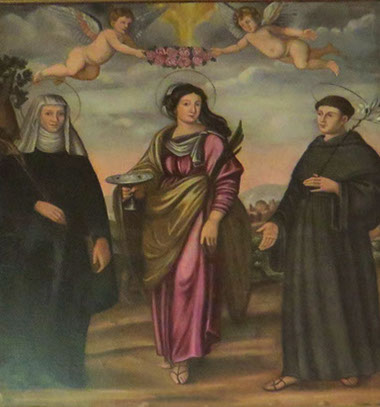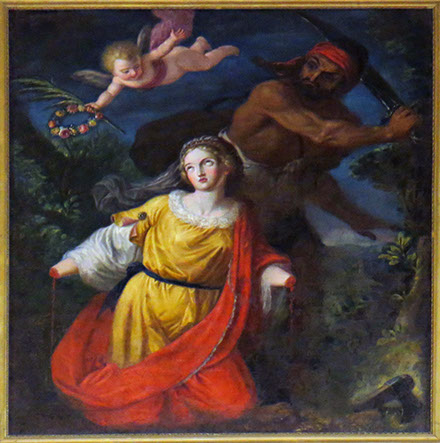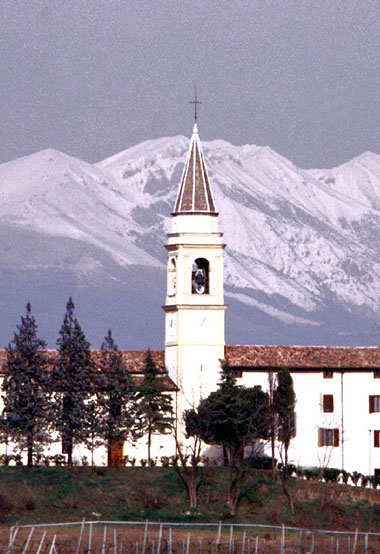Progetto di valorizzazione
del territorio di Valeggio sul Mincio
Chiesa Parrocchiale
di Santa Lucia ai Monti
XVI SECOLO
La storia della chiesa di Santa Lucia ai Monti inizia sul finire del XVI secolo, quando la piccola comunità collinare riuscì a costruire il primo edificio sacro, grazie alle monache del monastero di Santa Lucia d'Ognissanti in Verona, che avevano donato il terreno e 50 ducati, e ai benefattori valeggiani P. A. Barola e G. Marchi.
La prima pietra della chiesa di Monte Cocolo, così si chiamava il villaggio, ebbe luogo il 18 aprile 1595.
Non è noto quando fu benedetta la chiesa, dedicata alla martire siracusana in onore del munifico monastero veronese, risulta comunque che nel dicembre del 1595 la fabbrica era pressoché conclusa, compresa la canonica, a cui era affiancato un pezzo di terra che il sacerdote poteva coltivare per il proprio sostentamento.
In seguito, il toponimo mutò da Monte Cocolo in Santa Lucia ai Monti (nel corso del XIX secolo fu anche usata la dicitura Santa Lucia del Tione).
La curazia è stata retta dai sacerdoti della pieve di Valeggio fino al 1926, quando fu elevata in parrocchia dal vescovo di Verona, mons. G. Cardinale (1875-1954).
All’interno, semplice ma curato, sono conservate due pregevoli tele.
La prima, posta sull’altare maggiore, raffigura la patrona Santa Lucia da Siracusa, fra Santa Toscana Vedova da Zevio (Verona) e Sant’Antonio di Padova; sopra la controfacciata, si può ammirare il martirio di Sant’Eurosia di Jaca, seconda patrona della chiesa.
Due cappelline laterali espongono le statue del Sacro Cuore di Gesù e della Madonna del Rosario. Altre due statuette, di S. Lucia e S. Eurosia, sono poste ai lati del presbiterio.
Nel 1965, fu installato nell’abside l’organo costruito dalla ditta Marchiori di Padova.
Il sacro edificio, testimone delle battaglie risorgimentali del XIX secolo, durante le quali fu danneggiato da alcuni colpi di artiglieria, è stato più volte restaurato ma ha sempre mantenuto intatto il fascino della sua lineare bellezza.
Visibile da lontano, con il campanile a cuspide ornato di orologio, domina l’abitato e l’ameno paesaggio collinare.
Sul panoramico sagrato si trova il cippo che ricorda coloro che sono caduti per la riunificazione d’Italia, eretto nel 1966, nel primo centenario della terza guerra d’indipendenza.
Parish church of
Saint Lucy
16th CENTURY
The story of the church of Saint Lucy begins towards the end of the 16th century, when the small hill community managed to build their first sacred building, thanks to the nuns of the monastery of Saint Lucy in Verona, who had donated the land and 50 ducats, and to P. A. Barola and G. Marchi, two benefactors from Valeggio.
The first stone of the church of Monte Cocolo, thus was called the village, was laid on April 18th, 1595.
The date of consecration of the church is unknown, however, it is dedicated to Saint Lucy of Siracusa martyr, in honor to the bountiful Veronese monastery.
In December 1595 the construction was almost completed, including the rectory, to which was annexed a piece of land for the sustenance of the priest.
Later, the name was changed from Monte Cocolo to Santa Lucia ai Monti (Saint Lucy to the Mountains).
The church was run by priests of the church of Valeggio until 1926 when it was made a parish by the bishop of Verona, mons. G. Cardinale (1875-1954).
The interior, simple but well-finished, conserves two fine paintings.
The first, placed on the high altar, portrays the patron Saint Lucy from Siracusa, among those of Saint Toscana Widow from Zevio (Verona) and Saint Anthony of Padua; above the counter-facade, people can admire the martyrdom of Saint Eurosia of Jaca, second patron of the church.
Two small side chapels display the statues of the Sacred Heart of Jesus and of Our Lady of the Rosary.
Two other statuettes, that of S. Lucy and of S. Eurosia, are placed on the sides of the presbytery. In 1965, the organ constructed by the Marchiori company from Padua was installed in the apse.
The sacred building, witness of the battles of the Italian Risorgimento in the 19th century, during which it was damaged by artillery fire, was frequently restored, however always keeping the charm of its linear beauty intact.
Visible from afar, with its bell tower decorated with a clock, it dominates the town and the pleasant hill landscape.
In the panoramic courtyard rises the memorial stone, erected in 1966, on the first centenary of the third war of independence to commemorates those who died in the name of Italy.
Pfarrkirche
Santa Lucia ai Monti
16. Jhr.
Geistliche Route
Die Geschichte der Kirche von Santa Lucia ai Monti beginnt am Ende des 16. Jahrhunderts, als die kleine Berggemeinschaft dank der Klosterschwestern aus dem Kloster Santa Lucia d'Ognissanti in Verona, die ein Grundstück und 50 Dukaten spendeten, und der Gönner P. A. Barola und G. Marchi aus Valeggio das erste Gotteshaus errichten konnte.
Der Grundsteinlegung für die Kirche Monte Cocolo, wie sie in der Ortschaft genannt wurde, fand am 18. April 1595 statt. Es ist nicht bekannt, wann die Segnung der Kirche stattfand. Sie ist zu Ehren des Veroneser Klosters dem Märtyrer aus Syrakus geweiht.
Es ist jedoch belegt, dass das Werk samt Pfarrhaus im Dezember 1595 fast abgeschlossen war. Daneben lag ein Stück Land, das der Pfarrer für seinen Lebensunterhalt bebauen konnte. Später wurde der Name von Monte Cocolo in Santa Lucia ai Monti (während des 19. Jahrhunderts wurde auch die Bezeichnung Santa Lucia del Tione benutzt) abgeändert.
Mit der Verwaltung waren bis 1926 die Pfarrer der Pfarrkirche von Valeggio beauftragt, als die Kirche vom Bischof von Verona, Mons. G. Cardinale (1875-1954) zur Pfarrkirche erhoben wurde. Das Innere ist sehr einfach, aber gepflegt. Es enthält zwei kostbare Gemälde.
Das erste befindet sich auf dem Hochaltar und stellt die Schutzpatronin Santa Luzia aus Syrakus zwischen den Heiligen Toscana aus Zevio (Verona) und Antonius aus Padua dar. Oberhalb der Gegenfassade kann man das Martyrium der Heiligen Eurosia di Jaca bewundern, die die zweite Schutzheilige der Kirche ist.
Zwei Seitenkapellen enthalten die Statuen des Heiligen Herzens Jesu und der Rosenkranzmutter. Die beiden anderen kleine Statuen der Heiligen Luzia und der Heiligen Eurosia stehen an den Seiten des Presbyteriums. Im Jahr 1965 wurde in der Apsis eine Orgel der Firma Marchiori aus Padua errichtet.
Das Gotteshaus zeugt von den Schlachten im 19. Jahrhundert, während denen das Gebäude Schäden von einigen Einschlägen erlitt. Es wurde mehrmals renoviert, seine lineare Schönheit ist jedoch unverändert geblieben. Die Kirche mit ihrem Glockenturm mit Uhr, der das Wohngebiet und die anmutige Hügellandschaft überragt, ist aus der Ferne erkennbar.
Auf dem Panoramakirchenplatz befindet sich der Säulenstumpf, der an die Gefallenen während der Wiedervereinigung Italiens erinnert. Er wurde 1966 anlässlich der ersten Jahrhundertgedenkfeier an den dritten Unabhängigkeitskrieg errichtet.



S.Toscana - S.Lucia - S.Antonio

Santa Eurosia
© 2019
Comune di Valeggio sul Mincio (VR)
Associazione Percorsi


